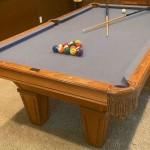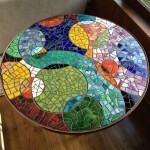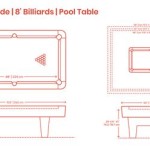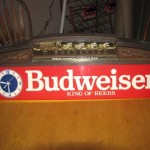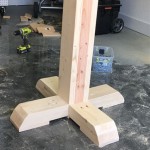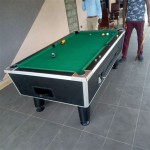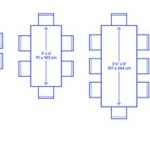What Is The Standard Bar Size Pool Table?
The identification of a "standard" size for a bar pool table is a common point of inquiry for individuals considering purchasing or utilizing such a table. While the term might suggest a universally consistent dimension, the reality is more nuanced. Bar pool tables, designed for commercial use and recreational play in public spaces, often deviate in size from the larger tables found in professional tournament settings or dedicated game rooms. This article aims to clarify the dimensions of a typical bar pool table, examining the factors that influence size variations and providing a comprehensive understanding of what constitutes a standard bar pool table.
Understanding the dimensions of a bar pool table is essential for several reasons. Firstly, it impacts the gameplay experience. A smaller playing surface necessitates different strategic approaches and shot executions compared to a larger table. Secondly, the table's size is a crucial consideration when assessing the available space in a bar or recreational area. Overcrowding can detract from the playing experience and create logistical challenges. Finally, knowing the standard dimensions can aid in the selection of appropriate pool cues, balls, and other accessories, ensuring compatibility and optimal performance.
The term "bar size" in relation to pool tables generally refers to tables that are smaller than the regulation tournament size. This size reduction allows for more tables to be accommodated in a bar setting and often caters to quicker, more casual games. While variations exist, certain dimensions are more prevalent than others in commercial establishments. These dimensions have evolved over time, influenced by factors such as cost, space constraints, and the desire to appeal to a broad range of players.
Defining the "Standard" Bar Size: The 7-Foot Pool Table
The most commonly encountered size for a bar pool table is the 7-foot table. This designation refers to the length of the playing surface, which is the distance between the noses of the cushions on opposite sides of the table. A 7-foot pool table typically measures 84 inches (7 feet) in length and 42 inches (3.5 feet) in width for the playing surface. The overall dimensions, including the rails and any decorative trim, are usually slightly larger, typically around 93 inches long and 52 inches wide. This size offers a reasonable balance between playability and space efficiency, making it a suitable choice for many bars and pubs.
The widespread adoption of the 7-foot table as the "standard" for bars is rooted in practical considerations. It is large enough to provide a challenging and engaging game, allowing for a variety of shots and strategic plays. However, it is also compact enough to fit comfortably in most commercial settings without dominating the space. The smaller size also translates to lower production costs, making it a more affordable option for bar owners who need to purchase multiple tables.
Furthermore, the 7-foot table offers a good compromise in terms of skill level. It is generally considered easier to play on than a larger, regulation-size table, which can be intimidating for novice or casual players. This accessibility makes it more appealing to a broader customer base, encouraging more people to participate and enjoy the game. The dimensions allow for quicker games, catering to the fast-paced environment often found in bars and pubs.
Factors Influencing Size Variations in Bar Pool Tables
While the 7-foot table is considered the standard, some variations exist in the size of bar pool tables. These variations are influenced by several factors, including the bar's available space, budget constraints, and the desired aesthetic. Some bars may opt for slightly smaller tables to maximize the number of playing surfaces, while others may choose larger tables to provide a more premium gaming experience. These minor deviations contribute to the diverse range of pool tables encountered in commercial settings.
One factor influencing size variations is the physical limitations of the bar itself. Older establishments may have limited space, necessitating the use of smaller tables to accommodate other amenities and customer seating. Conversely, newer or larger bars may have the space to accommodate larger tables, offering a more spacious and luxurious playing environment. The size of the room dictates the maximum dimensions of the pool table and influences the owner's choice of table size.
Budgetary considerations also play a significant role. Smaller pool tables are generally less expensive than larger ones, both in terms of initial purchase price and ongoing maintenance costs. Bar owners operating on a tight budget may opt for smaller tables to minimize expenses. The cost of installation can also be a factor, as larger tables may require more specialized handling and installation procedures, further increasing the overall investment.
Finally, aesthetic preferences can influence the choice of table size. Some bar owners may prefer the look and feel of a larger table, believing that it enhances the overall ambiance of the establishment. The table's size can contribute to its visual presence and impact on the room's decor. The choice of materials, finishes, and overall design can also be influenced by the desired aesthetic, further contributing to the variations observed in bar pool tables.
Beyond Length and Width: Understanding Table Components
Beyond the overall length and width, other crucial components of a bar pool table influence its playability and overall quality. These components include the slate bed, the cushions, the cloth, and the pockets. Each of these elements contributes to the table's performance and should be carefully considered when evaluating a bar pool table. Variations in these components can significantly impact the gameplay experience, regardless of the table's overall size.
The slate bed is the foundation of the pool table, providing a flat and stable playing surface. The thickness and quality of the slate directly impact the table's accuracy and responsiveness. Thicker slate beds are generally preferred, as they are less prone to warping or deflection, ensuring a consistent playing surface over time. Bar pool tables commonly use slate beds, but the quality and thickness may vary depending on the cost and intended use of the table.
The cushions, also known as rails, are the rubber bumpers that line the perimeter of the playing surface. High-quality cushions provide consistent rebound and accurate ball deflection, allowing for precise shots and strategic plays. The composition and construction of the cushions greatly influence their performance. Bar pool tables should ideally have responsive and durable cushions that can withstand frequent use and maintain their performance over time.
The cloth covering the slate bed is another critical component. The type of cloth, its weave, and its nap affect the ball's speed and trajectory. Tighter weaves and smoother surfaces generally result in faster ball speeds and more predictable ball behavior. Bar pool tables often use a more durable cloth designed to withstand heavy use and resist tearing. However, the quality of the cloth can still vary, impacting the overall playing experience.
The pockets of a bar pool table also play a role in the game. The size and shape of the pockets, as well as the material used in their construction, can affect the ease with which balls can be pocketed. Tighter pockets generally require more precision and skill, while larger pockets are more forgiving. The pocket openings should be consistent and uniform to ensure fair and predictable gameplay. The material of the pocket can also influence the ball's behavior upon entry, potentially affecting its trajectory and bounce.

The Official Size Of A Pool Table Canadian Home Leisure

What Is The Standard Size Of A Pool Table Measurement Guide Room

Pool Table Room Size Guide Chart Birkbeck Billiards

Pool Table Sizing Dimensions Bar

Pool Table Room Size Guide Chart Birkbeck Billiards

Pool Table Room Size Calculator

Correct Pool Table Dimensions To Leave Enough Room For Playing Billiard

Room Size Specifications Olhausen Billiards

Room Size Pooltables Com

Pool Table Size Chart Moving The Experts

